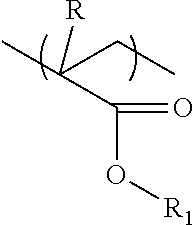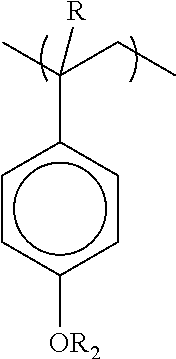Nanocomposite positive photosensitive composition and use thereof
- Summary
- Abstract
- Description
- Claims
- Application Information
AI Technical Summary
Benefits of technology
Problems solved by technology
Method used
Image
Examples
formulation example 1
Preparation of Positive Nanocomposite Photoresists from AZ® GXR 601
[0059]Five solutions were prepared adding the NPC-ST-30 silica colloidal solution into AZ® GXR601 (from AZ® Electronic Materials USA Corp., 70 Meister Ave., Somerville, N.J. (a novolak polymer / diazonaphthoquinone diazide) photoresist in propylene glycol mono-methyl ether acetate with a solid content of 30.6% by weight), as shown in Table 1. The solutions were rolled overnight at room temperature and used without filtration. The solutions were transparent and the silica content was 30-70% by weight (solid matter base). The solvent content in the nanocomposite photoresists was about 69.3% by weight. The silica nanoparticles were incorporated into the polymer matrices homogeneously without agglomeration. No precipitation was observed after 3 months.
TABLE 1GXR601NPC-ST-30Silica content in solid(g)(g)(%, by weight)Sample 11000Sample 2104.530Sample 3106.640Sample 4101050Sample 5101560Sample 6102370
formulation example 2
AZ12XT: Diluted AZ® 12XT-20PL-5
[0060]Commercial AZ® 12XT-20PL-5 (solid content 30% by weight), available from AZ® Electronic Materials USA Corp. (novolak capped with acid labile / NIT in PGMEA) was diluted in PGMEA solvent by rolling over night. This dilution was done to enable this photoresist, normally for thick film application, to be applied as a 2 micron thick film. This diluted version of AZ® 12XT-20PL-5 was named AZ12XT.
formulation example 3
AZ® 12XT-NC Positive Nanocomposite Photoresist
[0061]A solution was prepared by adding 12.9 g of the NPC-ST-30 silica colloidal solution into 20 g of AZ® 12XT-20PL-5 (from AZ® Electronic Materials USA Corp.) to give a 40% by weight solids of silica. The solution was rolled overnight at room temperature and used without filtration. The solution was transparent. This formulation was named AZ® 12XT-NC and used for lithographic comparison as reported below. The silica nanoparticles formulated into AZ® 12XT were incorporated into the polymer matrices homogeneously without agglomeration. No precipitation was observed after 3 month. Similarly, other versions of this resist were prepared with 20 and 30% by weight silica by varying the amount of NPC-ST-30 solution employed and these were used in the etching studies reported below.
Lithography Example 1
[0062]The photoresist solutions from Table 1 were coated onto 6 inch silicon wafers and baked at 90° C. for 90 seconds to give a coating of 2 μm...
PUM
| Property | Measurement | Unit |
|---|---|---|
| thickness | aaaaa | aaaaa |
| particle diameter | aaaaa | aaaaa |
| thickness | aaaaa | aaaaa |
Abstract
Description
Claims
Application Information
 Login to View More
Login to View More - R&D
- Intellectual Property
- Life Sciences
- Materials
- Tech Scout
- Unparalleled Data Quality
- Higher Quality Content
- 60% Fewer Hallucinations
Browse by: Latest US Patents, China's latest patents, Technical Efficacy Thesaurus, Application Domain, Technology Topic, Popular Technical Reports.
© 2025 PatSnap. All rights reserved.Legal|Privacy policy|Modern Slavery Act Transparency Statement|Sitemap|About US| Contact US: help@patsnap.com


